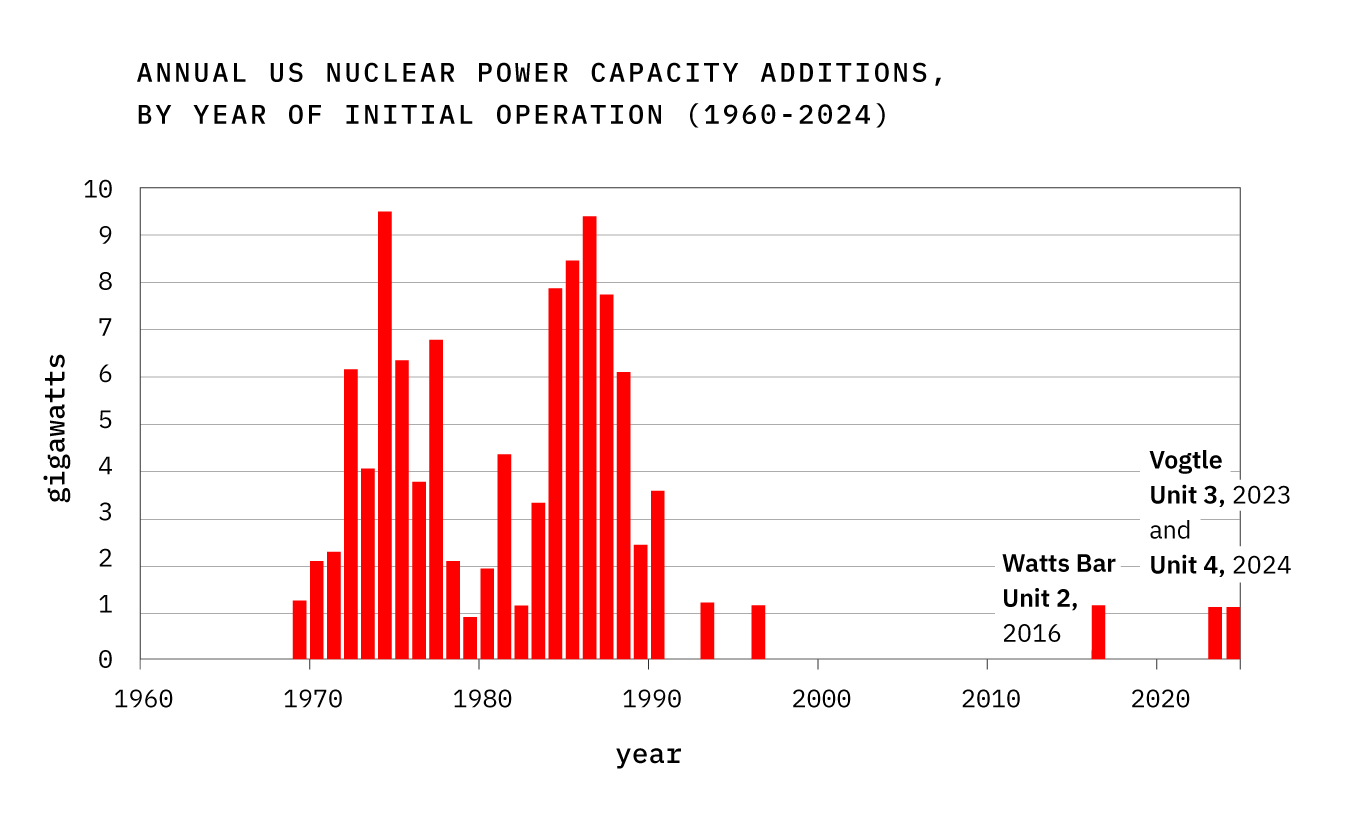It took five years and $1 billion (adjusted to current dollars) to permit and build the Connecticut Yankee nuclear plant, which began operating on January 1, 1968. In contrast, Vogtle’s nuclear reactors in Georgia took 14 years just to build and cost more than $30 billion before the two reactors became operational in 2023 and 2024.1 They were meant to become operational in 2016 and 2017.2 A large reason for this is simply poor regulation that holds the technology back.
The suffocating effects of nuclear regulation can be seen in this graphic from the Energy Information Administration. The early 1970s and mid-to-late 1980s saw surges in nuclear capacity coming online. Since then, however, additions have essentially stopped.

Consider two core problems in nuclear regulation–the “as low as reasonably achievable” or ALARA standard and the linear no-threshold (LNT) modeling. The unintended consequence of ALARA is that any cost savings in one area imply additional emissions reductions efforts can be pursued with those cost savings.3 As one engineer at a nuclear company put it, “the criteria is not whether the benefit of further reduction outweighs the cost. The criteria is: can you afford the reduction?”4
ALARA essentially means there is no incentive to cut costs since savings in one area imply additional safety efforts must be taken. The key issue is that there are not well-defined limits to this principle, so nuclear companies are held to a rule with no “numerical threshold that would satisfy this ALARA requirement.”5
Next, LNT ignores how dosages of radiation matter to their health effects. LNT assumes that any dose of ionizing radiation, no matter how small, has some potential to increase risks and that risk increases linearly with dose. The major outcome is the belief that there is no safe threshold.
Again, however, the LNT model makes little sense in practice. Radiation is all around us in everyday items and activities (e.g. granite countertops, bananas, and flying). Just as with sunbathing and so much else, it is the dosage and timing that matter. The LNT modeling does not account for this, and so prescribes mitigation efforts in excess of what would pass a cost-benefit test. In place of LNT, a better approach would be to adopt a model that suggests different responses based on the level of radiation emission exposure.6
Avoid the nirvana fallacy since all energies have risks
An important blind spot in current nuclear regulation is that other energy sources imply risks of the types that nuclear regulation is meant to prevent. That is, coal, gas, and oil all have emissions with different health effects. The failure to enable nuclear means these competing energy sources continue operating. The right question for policymakers is about balancing the risks of not using nuclear alongside the real but manageable risks of nuclear power.
Congress can revitalize and unleash the US nuclear industry by:
- Allocating federal lands to nuclear energy development.
- Condition federal energy funds on removing state-level bans on nuclear power.
- Replacing the “as low as reasonably achievable,” or ALARA standard, and linear no-threshold (LNT) modeling with risk-informed, performance-based frameworks.
- Allowing developers and operators to propose innovative safety measures under performance-based regulations rather than mandating processes that hinder technological advancement.
Regarding subsidies as a solution in nuclear energy policy, the order matters. That is, Congress should first rationalize nuclear regulation and then consider public subsidies if they are still necessary. Every industry will complain about regulation and request federal and state supports to be competitive. The merits of subsidies are a separate policy debate. Yet there are two benefits to pursuing red tape reforms before subsidizing. First, the costs are effectively zero to already burdened taxpayers. Second, subsidizing a heavily regulated area means few dollars complete anything other than red tape. Public dollars, if prudent, go further in lean systems than when spent doing bloated paperwork.
Nuclear can play an important role in a world of abundant and affordable energy. Policymakers need only to rationalize the rules that nuclear developers must follow. We can return to a world where nuclear is safe, low-cost, and common. If Congress enacts reforms like these, it will reduce energy costs for the entire country.
1 Josh T. Smith, “Connecticut Yankee: 5 Years and $1 Billion,” Powering Spaceship Earth, December 7, 2024, https://poweringspaceshipearth.substack.com/p/connecticut-yankee-5-years-and-1.
2 “Plant Vogtle Unit 4 Begins Commercial Operation – U.S. Energy Information Administration (EIA),” accessed March 25, 2025, https://www.eia.gov/todayinenergy/detail.php?id=61963.
3 Grant Dever, “The Urgency of Rethinking U.S. Nuclear Energy Regulation” (The Foundation for Research on Equal Opportunity, July 30, 2022), https://freopp.org/whitepapers/rethinking-u-s-nuclear-energy-regulation/.
4 Jack Devanney, “ALARA,” Gordian Knot News, April 5, 2023, https://jackdevanney.substack.com/p/alara.
5 Kyle Danish, Adam Stein, and Paul Libus, “Will Risk Aversion at the NRC Avert the Energy Transition?,” Environmental Law Reporter, 2024, https://www.vnf.com/webfiles/2024%200301%20ELR.pdf.
6 Dever, “The Urgency of Rethinking U.S. Nuclear Energy Regulation.”